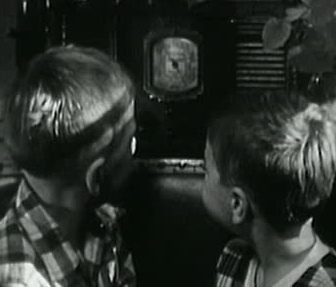 To most Australians these days, international sport on Boxing Day means the Test Match at the MCG. But it was different fifty years ago. Boxing Day meant tennis, and the start of the Davis Cup “Challenge Round”. To 1950s sporting fans this was the World Cup of tennis, with the two top teams playing off. What made it even better was that one of those teams was nearly always Australia. Our champion tennis players of the day were great national heroes with a status not much below that of Don Bradman.
To most Australians these days, international sport on Boxing Day means the Test Match at the MCG. But it was different fifty years ago. Boxing Day meant tennis, and the start of the Davis Cup “Challenge Round”. To 1950s sporting fans this was the World Cup of tennis, with the two top teams playing off. What made it even better was that one of those teams was nearly always Australia. Our champion tennis players of the day were great national heroes with a status not much below that of Don Bradman.
I especially remember three of those Davis Cup finals. The first started on Boxing Day 1951. I was ten years old and on holiday with my family at Middleton Beach, Albany, on the south coast of Western Australia. This was my first taste of the passions associated with international sporting contests and my first stirrings of pride in being Australian. I can also remember the impact of these events on my family, especially the intense interest of my father. Dad was not a great sportsman, but he was a great follower, and he passionately supported his sporting heroes. Even my mother, who knew nothing about sport and had no interest in it, appreciated the drama of a Davis Cup final.
Holiday fun, indeed family life as a whole, came to a standstill when the tennis was on. We sat around 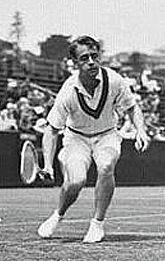 the radio, revelling in the tension and excitement, the wonderful sound effects and the ebb and flow of the game. We hung on the ABC’s ball-by-ball commentary and the expert insights of former star Adrian Quist (pictured at right) .[i] The commentators were particularly skilful in conjuring up the imagery of the venue and the game, and they used graphic adjectives and tennis jargon, such as “crisp volleys”, “clean winners”, “cannonball serves”, “deep heavy balls”, “blistering groundstokes”, “brought up the chalk” and so on. In pre-television days, the radio call itself was integral to the drama.
the radio, revelling in the tension and excitement, the wonderful sound effects and the ebb and flow of the game. We hung on the ABC’s ball-by-ball commentary and the expert insights of former star Adrian Quist (pictured at right) .[i] The commentators were particularly skilful in conjuring up the imagery of the venue and the game, and they used graphic adjectives and tennis jargon, such as “crisp volleys”, “clean winners”, “cannonball serves”, “deep heavy balls”, “blistering groundstokes”, “brought up the chalk” and so on. In pre-television days, the radio call itself was integral to the drama.
Australia had unexpectedly beaten the Americans in the 1950 Cup final at Forest Hills. However, my father gave us little chance for the 1951 final. The powerful American team comprised Dick Savitt, Ted Schroeder, Tony Trabert and Vic Seixas, all of whom had or would win Wimbledon. The Australians were led by the formidable Frank Sedgman, my father’s greatest sporting hero and one of the finest players of all time. He was partnered by the tall and athletic Ken McGregor.
Then, for some unfathomable reason, the selectors blundered and chose the left-handed Mervyn Rose instead of McGregor to play in the singles; Rose lost both his matches. But Sedgman beat Trabert, and he and McGregor won the doubles. So, it all came down to the final match: Sedgman versus Seixas. I can still remember the cheer that went up around our little holiday cottage at the first point of the match – Seixas served to Sedgman, who cracked his forehand return for a “clean” winner – and later the celebrations when he triumphed in straight sets to ensure the Cup stayed in Australia. My father had a smile on his face for days afterwards, typical of the glow of pride and goodwill-to-all that enveloped the entire nation.
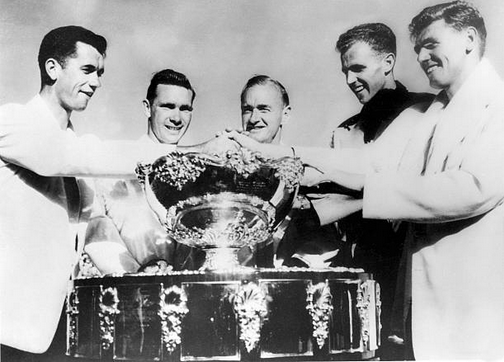
Victory is ours: Australia’s 1951 Davis Cup squad.
A year later, on the Boxing Day of 1952 our family was again on holiday at the coast, and this year we listened to the Cup final in a cottage at Palm Beach, near Rockingham. The tie was played at the Memorial Drive courts in Adelaide. My father read in the paper that nearly 10,000 people turned up on the lead-up days simply to watch the teams practice, giving an idea of how immensely popular tennis was at the time. The Australian team was Sedgman and McGregor and America was represented by Trabert and Seixas. Although my father believed that Sedgman had an edge over both of the Americans, he considered that they would have little trouble defeating McGregor. Naturally I agreed, my father being my only source of tennis wisdom at the time, and this was before I had realised that he was by inclination a sporting pessimist. Even so, he had a point. This was still the days when the Davis Cup was confined to amateurs and Ken McGregor was only a part-time player. Astonishing to modern tennis followers, he spent his winters playing Aussie Rules football, where he was a champion ruckman in South Australia. But he was a magnificent sportsman and competitor, and he had been relentlessly trained by the Australian captain Harry Hopman in the weeks leading up to the Cup final.
On the opening day, as predicted, Sedgman cleaned up Seixas. Then McGregor came out and played superbly to beat Trabert. McGregor’s uncompromising strategy in this match (as explained to us by Adrian Quist) was never to lose his serve, and then take his chances when Trabert was serving. He did this to perfection, winning in straight sets. The next day he teamed with Sedgman to win the doubles and give Australia an unbeatable 3-0 lead. The Cup was ours for another year.
But this time, the national tidal wave of pride and happiness was cut short. Immediately after the 1952 final, Sedgman and McGregor turned pro, and immediately after that, the blimpish Australian tennis authorities banned them from playing Davis Cup ever again. It was my father’s view, even more pessimistic than usual, that this rang a death knell for Australia’s dominance of world tennis, and I can recall to this day his doleful expression as he walked down to Palm Beach for a swim, whistling lugubriously.
However, what transpired the following year became one of the nation’s greatest sporting triumphs. It brought the smile back to my father’s face – and not just because of the tennis.
In 1953 I was in Year 7 at Nedlands State School and on one of the very last days of the school year I was accidentally struck in the eye by a sharp stone. I ended up spending some weeks in St John of God’s Hospital. Both eyes were bandaged, and I was forced to lie inert day and night while (the Doctor hoped) the eye healed. By Boxing Day I had been allowed to go home, but both eyes were still bandaged. I lived in a world of darkness and enforced inactivity. It was a trying and depressing time for me and one of great anxiety for my family. It was still not known whether my eyesight had been permanently damaged. There was no family holiday by the beach that summer. But I listened to the 1953 Davis Cup final – blindfolded, and mostly lying on the lounge room floor.
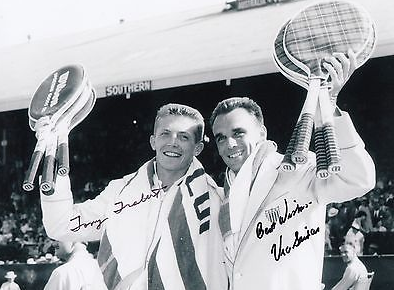 The match was played on the grass at Kooyong in Melbourne, and the Americans were again represented by the formidable team of Vic Seixas and Tony Trabert (right). The crew-cut and muscular Trabert was particularly feared, but both men were champion players and experienced and toughened Davis Cup veterans. The Australian team comprised two 18-year olds, Ken Rosewall and Lew Hoad. Both had been outstanding juniors, and Rosewall had actually won the Australian and French Championships that year, but they had not previously played for their country, and had somehow slipped under the media’s radar. They were almost unknown, or still looked upon as promising juniors, and my father gave them no hope.
The match was played on the grass at Kooyong in Melbourne, and the Americans were again represented by the formidable team of Vic Seixas and Tony Trabert (right). The crew-cut and muscular Trabert was particularly feared, but both men were champion players and experienced and toughened Davis Cup veterans. The Australian team comprised two 18-year olds, Ken Rosewall and Lew Hoad. Both had been outstanding juniors, and Rosewall had actually won the Australian and French Championships that year, but they had not previously played for their country, and had somehow slipped under the media’s radar. They were almost unknown, or still looked upon as promising juniors, and my father gave them no hope.
I didn’t miss hearing a ball of the five matches in that final. Lew Hoad was magnificent in winning the opening match against Seixas, but then Trabert also played wonderfully to defeat Rosewall, to make it one-all going into the second day. Again the selectors bungled! Rosewall was dropped from the doubles, and a scratch pairing of Hoad and Rex Hartwig were substituted[ii]. They were no match for Trabert and Seixas. Then on the third day came one of the great tennis matches of all time: Hoad v Trabert. After five glorious sets, the last two played in slippery conditions, Hoad triumphed.
So, just as in 1951, again it all came down to the last match, this time Rosewall v Seixas. To add to the 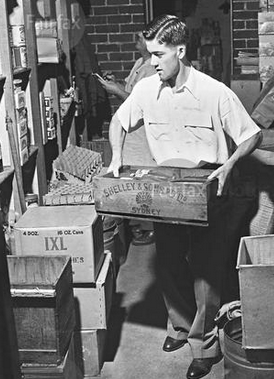 drama, the game was delayed until the fourth day due to the drizzle which had fallen during the climactic final hour of the Hoad-Trabert match. Thus the boy Rosewall, who had lost to Trabert on the first day, and then was unexpectedly dropped from the doubles on the second, suddenly found his Cup-deciding match with Seixas postponed for 24 hours until the fourth. Under fearful pressure, in front of 18,000 spectators and with the whole of Australia at a standstill listening to their radios, Rosewall won. It was not that Seixas played badly – he fought magnificently. But Rosewall was in command from the outset, deceiving Seixas with angled volleys, delicate drop shots and baseline-kissing lobs, repeatedly hitting winners with his glittering backhand, and hardly missing a return of serve over four sets of tennis. I have since watched highlights of the match on video, including the final point with Rosewall at the net putting away a crushing forehand volley. However, I had already “seen” the entire match in my mind’s eye at the time, and I can still remember how it lifted my spirits. From that moment, my recuperation was never in doubt. As for Rosewall, things were different then. Having brought glory to Australia, he was snapped by the press stacking boxes at his parents’ grocery store (above).
drama, the game was delayed until the fourth day due to the drizzle which had fallen during the climactic final hour of the Hoad-Trabert match. Thus the boy Rosewall, who had lost to Trabert on the first day, and then was unexpectedly dropped from the doubles on the second, suddenly found his Cup-deciding match with Seixas postponed for 24 hours until the fourth. Under fearful pressure, in front of 18,000 spectators and with the whole of Australia at a standstill listening to their radios, Rosewall won. It was not that Seixas played badly – he fought magnificently. But Rosewall was in command from the outset, deceiving Seixas with angled volleys, delicate drop shots and baseline-kissing lobs, repeatedly hitting winners with his glittering backhand, and hardly missing a return of serve over four sets of tennis. I have since watched highlights of the match on video, including the final point with Rosewall at the net putting away a crushing forehand volley. However, I had already “seen” the entire match in my mind’s eye at the time, and I can still remember how it lifted my spirits. From that moment, my recuperation was never in doubt. As for Rosewall, things were different then. Having brought glory to Australia, he was snapped by the press stacking boxes at his parents’ grocery store (above).
Australia is a fourth-rate tennis nation today, and there are no Davis Cup finals on Boxing Day, nor is sport any longer brought to us solely by radio, which demands concentration to visualise the unfolding drama. Today’s sports fans watch TV, and it is always cricket on Boxing Day, with the good bits played and replayed from every angle to the point where the sensational becomes almost boring, and the flow of the match is constantly interrupted by mind-numbing commercials. The TV commentators are not expert callers, as was the case on radio, but has-been players with self-serving and selective memories. I love cricket, and I admit I watch the Boxing Day Test on television, although wherever possible I listen to the radio commentary.
But there are still times when those Boxing Days of fifty years ago “flash upon that inward eye, which is the bliss of solitude”. Then I see again those magnificent young Aussie tennis players of the day, hear the rifle crack of racquet on ball echoing around a breathless stadium, and see the smile and excitement on my father’s face as a Davis Cup Final moved to its gut-wrenching climax.
And I also remember the wonderful sportsmanship of those 1950s tennis players, both Australian and American. They were proud to be representing their country and their sport and of their own position as sporting champions. Umpires were not queried or abused, opponents were treated with respect, and winners and losers equally behaved with impeccable dignity.
As for my “outward” eye, well, it was badly damaged, and I only ever recovered some peripheral vision in it, but overall I was lucky and life went on. I was even able to return to the tennis court, where mostly I played badly. Mind you, on one memorable occasion my brother and I did almost make it into the Australian Davis Cup team…….but that’s another story[iii].
Roger Underwood is a former firefighter and a district and regional manager with the Forests Department in WA.This memoir was published at Quadrant Online in 2010.
[i] 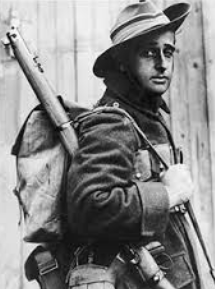 Quist had been a member of the last Australian team to win the Davis Cup. During the second day of the match, World War II was declared. Quist, a wonderful tennis commentator, combining a soft, confidential tone of voice with deep tennis knowledge, immediately joined the Army (right).
Quist had been a member of the last Australian team to win the Davis Cup. During the second day of the match, World War II was declared. Quist, a wonderful tennis commentator, combining a soft, confidential tone of voice with deep tennis knowledge, immediately joined the Army (right).
[ii] Hartwig was a wonderful doubles player, but temperamental, and when he was teamed with Hoad, was forced to play in the wrong position. I once ball-boyed in a match in which Hartwig was playing at Royal Kings Park tennis club, and I have never seen such miraculous volleying.
[iii] See Sporting Glory in Tree Climber – the education of a Forester by Roger Underwood. York Gum Publishing, 2003
 Sign In
Sign In 0 Items (
0 Items ( Search
Search









“Pride in Australia”? Playing to win for your nation and the grief of defeat?
How last century … – and one that I long for
“Umpires were not queried or abused, opponents were treated with respect, and winners and losers equally behaved with impeccable dignity.”
Thank you, Roger, for memories of an era long gone and unlikely to recur.